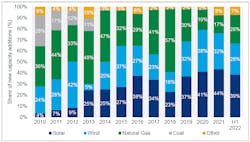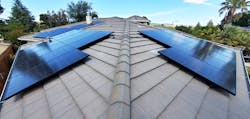When most people hear “off-grid house,” the first image that usually comes to mind is a cabin in a remote area that’s home to a “prepper” or a young couple looking for a carbon-free lifestyle. Probably the last thing you’d envision is a $1.3-million, 4,000-square-foot home in one of the country’s oldest and wealthiest suburbs, whose notables include George Brett and the founders of Hallmark and H&R Block.
But as surprising as that might be, the latter home in Mission Hills, Kan. (see Photo 2), is just one example of how off-grid is starting to grow beyond a niche market into a mainstream lifestyle (both geographically and demographically). This nascent trend creates a variety of opportunities for electrical contractors — from installing solar panels and battery energy storage systems (BESSs) to implementing smart home technologies that help achieve “net-zero” status, such as automated window shades that reduce AC usage during peak daylight.
Several factors are prompting more homeowners to consider solar, whether it’s to replace the grid or augment it.
“Demand for rooftop solar is at historic highs in the face of power outages and increasing electricity prices,” according to the “U.S. Solar Market Insight Q3 2022” report from research firm Wood Mackenzie and the Solar Energy Industries Association (SEIA) and illustrated in Fig. 1.
“The residential solar segment set a record for the fifth consecutive quarter with nearly 180,000 American households installing solar in Q2. The Inflation Reduction Act (IRA) will drive an additional 7.3GW of residential solar capacity over the next five years, and the new standalone storage tax credit across all market segments is expected to improve grid reliability.”
Refer to Fig. 2 and 3 from the report for additional data on U.S. solar photovoltaic forecasts.
Green arguably is the top reason why homeowners want to be off grid, or as close as possible — and not just the green of having a small carbon footprint.
“Residential solar is driven by the solar installations meeting customers’ consumption and having net metering or net billing arrangements to get on-bill savings,” says Michelle Davis, Wood Mackenzie principal analyst.
Powerless to change
Technically, the Mission Hills home isn’t 100% off grid, but rather “zero-grid” or “grid-tied,” meaning it’s still connected — but barely. That’s still the norm for a variety of reasons, none of which has to do with lack of will. For example, sometimes laws require urban and suburban homes to be connected to the local utility. In other cases, homeowners want that connection so they can sell excess power to the utility.
“Our electric bills are nothing compared to our neighbors,” the Mission Hills homeowners explain in a testimonial for Platte City, Mo.-based Solar Design Studio, which engineered the system and serves clients in the Midwest and West Coast. “Sometimes they are negative, meaning I have a credit for future use.”
Their quest to be as close to off grid as possible is also driven by unreliability due to factors such as rolling blackouts and old infrastructure that’s vulnerable to wind and ice storms.
“That area has a lot of power outages,” says Bob Solger, founder and managing partner of Solar Design Studio.
In Kansas City and elsewhere, sometimes outages are due to problems on the generation side rather than downed power lines.
“Is the natural gas plant going to freeze when it gets cold?” says James Owen, executive director of Renew Missouri, a lobbyist group. “Is the nuclear power plant going to be down for six months’ worth of maintenance as they’re required to do about once every 18 months? All of these forces are going to make a lot of customers say, ‘I would rather decentralize where my power comes from and not have to worry about whether the wind turbines are blowing in western Kansas.’”
And even when they are, their local utility might not be able to access that wind power.
“The fact that there’s no political will among lawmakers in Kansas or Missouri to facilitate transmission lines is a big problem that Evergy has to face,” Owen says.
Bigger than zero
Just how big is the off-grid/zero-grid solar market? The answer depends on whom you ask.
“This type of setup is incredibly rare,” says Wood Mackenzie’s Davis. “It would represent a rounding error on our total installs numbers, if that. Off-grid or export-only arrangements do happen, but they are incredibly rare compared to the main market of net-metered installations. We don’t hear from installers that these types of installations are growing in any significant way.”
But other members of the solar ecosystem see growing interest.
“We talk to a fair amount of people who are interested in this,” Owen says.
So does greenpenny, a Decorah, Iowa-based bank that finances commercial and residential solar projects in five Midwestern states.
“We get inquiries about going entirely off grid with some regularity,” says Jason MacDuff, president. “However, at the end of the day, most of our customers end up deciding to stay connected to the grid as a backup in case something goes wrong (e.g., power goes out, they do not have enough stored in their batteries, etc.). That could change over time. We’re just at the beginning of the energy transformation.”
Interest is high on the West Coast, too.
View a photo gallery of off-grid/zero-grid projects, such as the home in Photo 1 and Photo 3 designed by Anacapa Architecture.
Who’s in power?
The pandemic also forced many people to work from home, where reliable power took on new importance. For those who chose to make this workstyle permanent, solar with BESS could be an attractive alternative to the traditional back-up generator. They also may be able write off a portion of the system as a business expense.
“Power outages have the same impact. So while I’m sure some folks might be thinking about writing solar off as a business expense, this isn’t something that we’ve heard of as a specific driver of residential solar.”
Whatever the motivation, BESS is increasingly becoming a requirement.
“Over the last two years, we’ve been seeing more and more people interested in adding a storage or battery backup to their system,” says Solar Design Studio’s Solger. “The last six or so years, battery storage has become more of a component that’s become available for the grid-tied marketplace.”
Another barrier could fall with passage of laws in Missouri and other states that bar homeowners associations (HOAs) from prohibiting or limiting solar panels.
“I think that is going to really help the market because I get like a dozen to 15 calls a year from people having these problems,” Owen says. “Most of them, for whatever reason, came from the Kansas City area.”
The 1996 federal Telecommunications Act prohibited municipalities and HOAs from restricting the installation of satellite dishes, ushering in new competitors to cable. State solar laws could have a similar effect on electric utilities.
“I use that analogy in front of the legislature all the time when we’re advocating for this legislation,” Owen says.
But in some places, HOAs could actually help. One example is new construction where an entire neighborhood is off grid from day one, such as a country subdivision.
“The most questions I get are for people who don’t want to do it just for their house,” Owen says. “They want to do it for a neighborhood. In Missouri, if it’s not connected to the grid, there’s very little, if any, regulation of that.
“There was a case last year in front of the Public Service Commission where a group from Saint James wanted to get permission to do this. The PSC said: ‘You don’t need permission from us. You’re not a utility. You’re not selling this to the public. You can just do this.’ And that was it. They dismissed it.”
Some utilities might encourage a variant of this model because it’s cheaper and more reliable than extending transmission and distribution to a new planned community in a rural area, especially if it’s prone to outages. One example is a remote, six-home subdivision fed by a distribution line that passes through an area where wildfires are common
“We’re working with PG&E on concepts installing some kind of battery and solar install in these really remote systems,” Brian McDonald, senior vice president for San Jose, Calif.-based Cupertino Electric, Inc. (CEI), told EC&M in 2020. “We’re finding it’s a lot cheaper to do that than run a new 20-mile line for a very small amount of load.”
Bills go up while costs go down
President Biden signed the IRA into law on August 16, and it’s already shaping up to be another major driver.
“The IRA has a lot of implications on what’s going to happen with the country’s use of energy and where it’s coming from,” says Barry Cinnamon, CEO of Campbell, Calif.-based Cinnamon Energy Systems. “We’re trying to figure out how we adjust our business planning as a solar and storage and electrical contracting company to addressing the expansion in those technologies.”
One reason why the IRA could drive more off-grid and zero-grid installations is simply because it makes solar a viable option for more demographics.
Photo 4 and Photo 5 demonstrate the types of off-grid/zero-grid/grid-tied residential projects Cinnamon Energy Systems has completed recently.
The IRA incentives also come at a time when utility bills are skyrocketing.
“From what we hear, the rising costs of electricity are contributing to the interest in solar as much as anything,” says Jessica Reis, greenpenny vice president and director of marketing and communications. “That’s what starts the homeowner to look into solar. Once they start to really understand the investment, the federal, state, and local incentives make the decision to move forward an easy one. Homeowners also take a lot of pride in helping the environment on a personal level.”
Even with incentives, some homeowners might assume that adding insulation or replacing windows offers more bang for the buck. But that’s not necessarily the case.
“I did a whitepaper looking at how you reduce energy costs in a house,” Cinnamon says. “What really came out screamingly obvious is cheaper on a retrofit basis to put solar panels on the roof than to super insulate and take these extraordinary measures with heat exchangers and things like that.”
About the Author
Tim Kridel
Freelance Writer
Kridel is an independent analyst and freelance writer with experience in covering technology, telecommunications, and more. He can be reached at [email protected].








